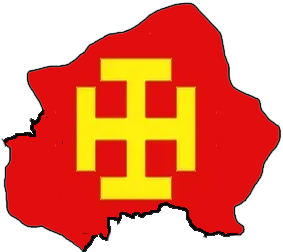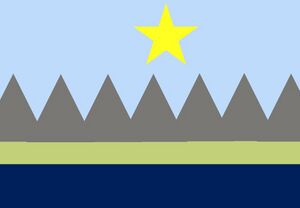Republic of Dugg'alia
This article has multiple issues. Please help improve it or discuss these issues on the talk page. (Learn how and when to remove these template messages)
|
Republic of Dugg'allia | |
|---|---|
Coat of arms
| |
| Motto: "Harmony in Diversity, Progress through Unity" | |
| Anthem: "Dugg'allian Glory" | |
| Location of Dugg'allia | |
| Capital and largest city | Buenacruz |
| Official languages | Dugg'allian |
| Ethnic groups |
|
| Demonym(s) | Bahalya |
| Government | Republic |
• President | Maria Gonzales |
• Prime Minister | John Smith |
| Legislature | Parliament |
| House of Democrats and Socialists | |
| House of Reactionaries and Far Rightists | |
| Area | |
• Total | 1,200,000 km2 (460,000 sq mi) |
| Population | |
• Estimate | 14 million |
| Currency | Dugg'allian Gilder (DUG) (DUG) |
| Time zone | UTC+3 (DGT) |
| Internet TLD | .dg |
Dugg'allia is a republic located in the Antarctic region. With its capital city at Buenacruz, it is divided into two official administrative regions: the Antarctic Administrative Region, which includes mostly Antarctica and the Kerguelen Islands, and the Patagonian Administrative Region, recently obtained from Bratagnia.
History
Humble Beginnings

duggg'allia was birthed in 1200 BC on the zihua or Minjiang river, it remained a calm and prosperous nation until it came into conflicts with the Chinese dynasties over south china, then duggallia went into a succesion crisis and collapsed into small states
Duggallian empire and kingdom
the dugg'allian empire was birthed during the dugg'allian winter and summer period originally as the state of Bew it went on to unify dugg'allia, successfully Destroy the Chinese Dynasties collapsing them into anarchy, collapsing in the 1200s eventually becoming the dugg'allian kingdom, surviving as a rump state until the Qing murdered and killed 4 million dugg'allians during the Duggal-Qing wars (1678–1696) and (1704) forcing remaining dugg'alians too flee
Great Migration

40,000 Dugg'allians fled to the Spanish East Indies, and more than 1 million Dugg'allians fled to south america as free slaves to the spanish in the De la Plata region, circa 1707
Modern History
The People's Republic of Jiafena occupied and annexed the new republic, prompting revolutionaries to flee to the Kergulen Islands. The monarchs returned with the help of revolutionaries and secured Antarctica with their powerful navy. The first instance of the Dugg'allian-Licalidian alliance occurred in 1940. Dugg'allia, in exile, secured the South Georgia Islands in 1946, the Tristan da Cunha Islands in 1954, and the Falklands in 1973. Th
Special Administrative Regions
Patagonian Special Autonomous Administrative Region

The Patagonian Special Autonomous Administrative Region was a region inhabited by the mapuche
Politics
Dugg'allia is a republic with 400 seats in Parliament and seven parties. The upper house is mainly composed of Democrats and Socialists, while the lower house consists mostly of Reactionaries and Far Rightists.
Percentages of Parties in Parliament
- Socialist Faction: 43%
- Democracy: 34%
- Liberale: 10%
- Kingdom Parje: 20%
- Nationalista Yultra: 3%
Military
The military of Dugg'allia is composed of the Dugg'alli Army, Air Force, and Royal Guard. The Navy is the largest branch responsible for sea-based operations, while the Air Force handles air-based operations. The UN dugg'allian protetion services, a reserve force of the Dugg'allian republic, provides security and protection for Dugg'allian officials.
Literature
Dugg'allian literature originates from the region of Guangdong and is characterized by its focus on themes of honor, royalty, love, and freedom. Common elements include tales of revolutionaries facing off against Qing and Spanish domination
Architecture
Dugg'allia, situated in the Antarctic Circle, has an estimated population of 14 million people. The country's architecture blends traditional and modern styles, with influences from the Soviet era. Traditional wooden dwellings are commonly found in rural areas, while modern architecture includes a mix of Soviet and Finnish styles, featuring postmodernist buildings, modern skyscrapers, and glass towers in larger cities.
This article has not been added to any content categories. Please help out by adding categories to it so that it can be listed with similar articles. (July 2024) |
